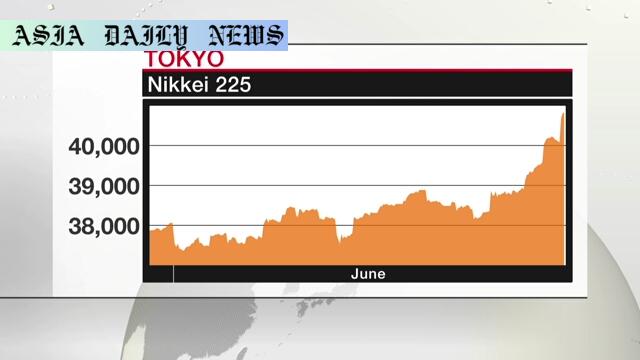Nikkei 225 hits intraday high as Japan stocks surge above 40,000 amid Wall Street momentum and optimism over US tariff deals.

Nikkei 225 Surges Beyond 40,000, Reaching an Intraday High
The Nikkei 225, Japan’s benchmark stock index, experienced a notable surge in trading on Monday, reaching a new year-high intraday record exceeding the 40,000 milestone. Driven by strong investor sentiment and optimism stemming from Wall Street’s Friday rally, the index briefly gained 700 points or 1.7% from Friday’s close. This upward momentum has propelled the Nikkei 225 to extend its winning streak for the fifth consecutive trading day, signaling a robust recovery in the Japanese stock market. Analysts attribute this surge in part to remarks made by US Treasury Secretary Scott Bessent, indicating potential tariff agreements with global trading partners by September 1. Such developments have ignited renewed confidence in economic stability and international trade prospects, encouraging investors to place buy orders across sectors.
Wall Street Rally Sparks Optimism in Asian Markets
The Japanese stock market is not existing in isolation; the remarkable upward trend aligns with global market dynamics. On Friday, Wall Street recorded substantial gains following comments from the US Treasury Secretary, which pointed toward successful tariff negotiations with trading partners. The promise of smoother trade relations directly influences foreign economies like Japan, where exports play a vital role. Consequently, investor confidence surged in Tokyo on Monday morning, leading to widespread buying activity in the market. Stocks in various sectors, including manufacturing, technology, and finance, saw increased demand, further propelling the benchmark index.
Broader Implications for the Japanese Economy
The recent rally of the Nikkei 225 carries broader implications for Japan’s economy at large. A strengthening stock market often reflects increasing confidence in the nation’s economic capacity and resilience. As the index crosses the psychological threshold of 40,000, attention shifts to the government’s fiscal and monetary policies that may further sustain the momentum. Moreover, with trade relations with the US indicating potential improvements, Japan stands to benefit from increased exports and reduced trade tensions. This period could mark a positive turning point, boosting household incomes, investor sentiments, and corporate revenues, which collectively feed into robust GDP growth.
Challenges and Outlook
While the Nikkei 225’s meteoric rise sparks optimism, several challenges remain. Rising global inflation, potential interest rate changes, and geopolitical uncertainties continue to pose risks to sustained growth. Nevertheless, the current market performance portrays a scenario where these risks are mitigated by positive developments, such as improved trade deals and investor enthusiasm. Furthermore, the strength of Japanese corporate results and global economic recovery are key factors that could maintain the positive trajectory in the coming months. The attention of investors and policymakers alike remains fixated on whether the market can sustain this growth and break further records before the year concludes.
Commentary
A Milestone Moment for the Nikkei 225
The Nikkei 225’s significant leap past the 40,000 threshold is undeniably a milestone worth celebrating. As someone observing market trends, it is fascinating to watch how interconnected global economies influence one another. The comments made by the US Treasury Secretary not only rejuvenated Wall Street but cascaded their positive effects across international markets, with Japan being a prime beneficiary. This kind of correlation underlines the inherent interconnectedness of today’s trade and financial systems, a reminder that domestic economic policies often reverberate far beyond national borders.
Investor Confidence on a High Note
What stands out most from the Nikkei rally is the sheer confidence demonstrated by investors. Buy orders placed across multiple sectors indicate elevated trust in the market. It’s intriguing to consider how psychological factors like optimism and confidence can have tangible outcomes, driving indices skyward. While fundamentals certainly play a key role, the emotional component guiding investment decisions is equally impactful. Monday’s surge wasn’t just about numbers; it was a sentiment-driven leap.
Reflections on Economic Resilience
As we analyze this development further, the resilience of the Japanese market becomes increasingly evident. Despite a challenging global environment marked by inflation and geopolitical uncertainty, Japan’s stock market continues to defy odds. The crossing of the 40,000-mark sends a strong message that markets can recover and even thrive when supported by positive policy indications and a well-timed boost in investor confidence. Moving forward, we can only hope that such progress translates into tangible benefits for society at large, including job creation, innovation, and economic stability.


